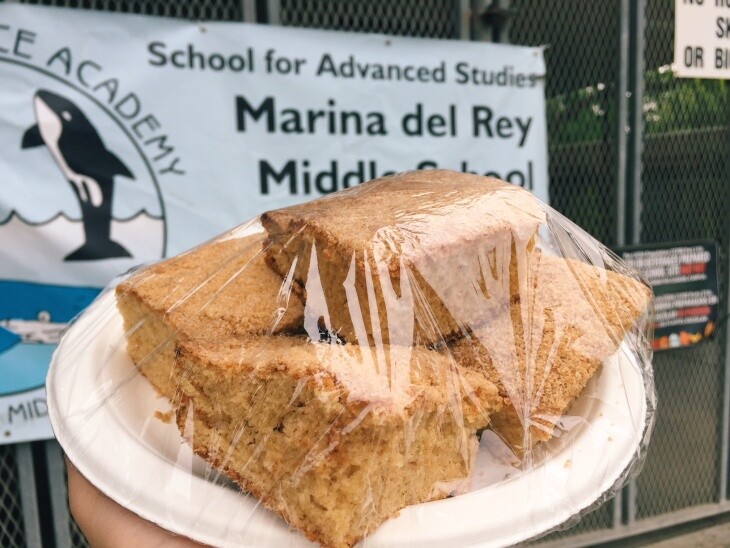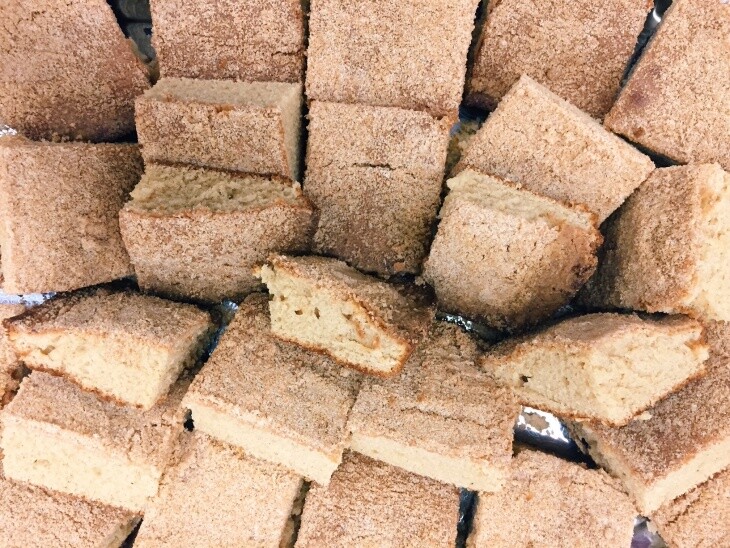Truth matters. Community matters. Your support makes both possible. LAist is one of the few places where news remains independent and free from political and corporate influence. Stand up for truth and for LAist. Make your year-end tax-deductible gift now.
LAUSD's Coffee Cake — Why Are People So Obsessed With It?

However you feel about teacher compensation, charter school funding or standardized testing, everyone connected to the Los Angeles Unified School District seems to agree on one thing — the greatness of LAUSD's coffee cake. Students, teachers, administrators, janitors... mention the coffee cake and they get a misty, contented look in their eye.
"It is warm and scrumptious and it is our soul food, here, when we're doing a parent meeting or something special where we just need something from the heart," says Lorraine Machado, the principal of Marina del Rey Middle School. She's also a coffee cake fan. She's certainly not alone.
"No doubt about it, it is our most popular item," says Manish Singh, LAUSD's interim director for food services. "We've introduced many things. Breakfast burritos, egg sausage sandwiches. You name it and we've done it. But nobody beats the coffee cake."

He estimates that the district's 700 or so cafeterias make about 800,000 servings of coffee cake per month amounting to more than 10 million servings each year. Impressive stats, especially since it only shows up on school menus twice a month. But there are other excuses to serve the treat. Nearly every time her school holds an event or a meeting, Machado says people request the coffee cake. When it does show up in the cafeteria, students can buy a slice for 75 cents while faculty pay $1.75.
With classes back in session at the district's approximately 900 schools,* cafeterias are working overtime to churn out the dessert for parent meetings, administrative committees and staff events. Okay, not literally overtime because it'd be way too expensive to pay staffers time-and-a-half just to bake cake (hyperbole!), but people really, really, really love the stuff.

What's the deal? Is it nostalgia? Has the LAUSD achieved some sort of culinary witchcraft? Or do people love this coffee cake because it's the best thing the LAUSD kitchens churn out?
Boyle Heights native Aaron Perez has been known to serve a version of the LAUSD coffee cake at his Whittier restaurant, Vaka Burger. Plenty of other recipes are floating around.
One of the most important elements of the coffee cake is its scent. Whenever the kitchen bakes it, you can smell the cinnamon and sugar wafting across campus.
"That's really one of the first things which happens with the coffee cake, as it goes out. Everybody gets that smell and the taste buds are already kind of salivating. They're just waiting to dig into it," Singh says.
Dusted with a crumbly, brown sugar topping, it's also substantial. Each fluffy slab is approximately two inches square.
"It's something like maybe grandma would've made. It's very comforting," Machado says.
Not all LAUSD coffee cakes are created equal. "I'm a bit of a foodie and all the cafeterias do a great job on the coffee cake but when I came and ate it at Marina del Rey, I felt that it had gone up a notch higher," Singh says.

Principal Machado credits Evelen Guirguis, the school's cafeteria manager.
Guirguis has been baking coffee cake for nearly two decades although the treat has been on school district menus for more than 60 years. The LAUSD's earliest coffee cake recipe dates to 1954. It features the basics — flour, sugar, water, cinnamon — as well as powdered nonfat milk, vinegar and "salad oil."

These days, LAUSD's coffee cake comes from a mix.
Guirguis leads me into the food storage area at Marina del Rey Middle School's cafeteria. Amid industrial-size tins of granola and giant cans of fruit, salsa and black beans, you'll find 51% Whole Grain Coffee Cake Mix from Buena Vista Foods.
Each 4.75-pound bag — which contains a blend of whole wheat flour, granulated sugar, brown sugar, unbleached wheat flour, nonfat milk, modified food starch, double acting baking powder, salt, soybean oil, cinnamon and nutmeg — makes 48 servings. Guirguis adds eggs, water, oil and a little bit of vinegar. She says the last ingredient enhances the smell and "breaks the taste little bit."
Nearby, you'll find 1.25-pound bags of coffee cake topping, also from Buena Vista Foods.
Guirguis is modest when asked why her coffee cake, of all the coffee cakes in all the cafeterias in the school district, is so special. "Because maybe you are in the west," she says with a laugh before she gets serious. "Because we make it from love, maybe."

The recipe has changed over the years, mostly due to regulations about the kind of food public schools can serve.
The Healthy Hunger-Free Kids Act, which became law in 2010, banned trans fats and artificial sweeteners and required schools to serve more whole grains. To comply with the law, LAUSD replaced some of the white flour in its coffee cake with whole grain flour. They also replaced the shortening with oil. So the cake in today's school cafeteria won't taste like the coffee cake from decades ago but whatever culinary sense-memory this dessert triggers, 10 million slices per year don't lie.

*That number doesn't include charter schools, which often have their own food service.







